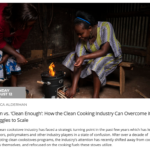Clean vs. ‘Clean Enough’: How the Clean Cooking Industry Can Overcome its Struggles to Scale

The clean cooking industry has faced a turning point which has left stakeholders in a state of confusion. The stakes of this debate are high and the wrong decision could leave millions behind.… read more









